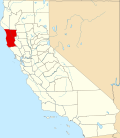References
- 1 2 U.S. Geological Survey Geographic Names Information System: Dapishul, California
- ↑ Hodge, Frederick Webb, ed. (1910), Handbook of American Indians North of Mexico, Part 2, Bulletin of the Smithsonian Institution Bureau of American Ethnology, vol. 30, Washington, Govt. print. off, p. 277
- ↑ Barrett, Samuel Alfred (1908), The Ethno-geography of the Pomo and Neighboring Indians, University of California Publications in American Archaeology and Ethnology, vol. 1, University of California Press, p. 144
39°19′38″N123°13′07″W / 39.3272°N 123.2185°W
